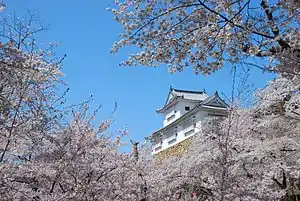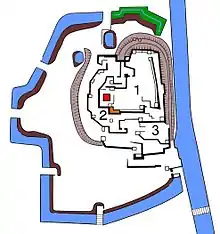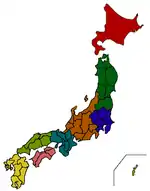Tsuyama Castle
Tsuyama Castle (Japanese: 津山城, Hepburn: Tsuyama-jō) is a castle in Sange, Tsuyama, Okayama prefecture, Japan. Tsuyama is home to one of Japan's three major hirayama (平山城 hilltop) style castles along with Himeji Castle and Matsuyama Castle (Iyo), which were constructed around the same time. During the Edo period, Tsuyama castle served as the primary residence of the government official and Lord of the Tsuyama Domain (Tsuyama han).
| Tsuyama Castle 津山城 | |
|---|---|
| Tsuyama, Okayama Prefecture, Japan | |
 | |
| Type | Azuchi-Momoyama castle |
| Height | (five stories) |
| Site information | |
| Controlled by | Yamana clan (1441–), Mori clan (1603–1697), Matsudaira clan (1698–1871), Japan (1873–present) |
| Condition | Mostly ruins, Bitchū-yagura reconstructed in 2005. |
| Site history | |
| Built | 1441–1444; major expansions 1603–1616 |
| Built by | Yamana clan (original); Mori Tadamasa (1603) |
| In use | 1616–1873 |
| Materials | stone, wood, plaster walls |
| Demolished | 1874–1875 |
Tsuyama Castle once had a complex of 77 structures. The main attraction is the garden, also known as Kakuzan Park (鶴山公園 Kakuzan Kouen). The garden has approximately 5,000 cherrytrees, which attracts visitors when their flowers bloom.
History


Muromachi period
1441-44: The shugo daimyō (守護大名) of Mimasaka Province, Yamana Norikiyo (山名教清), ordered his kin to build a castle in the Tsuru mountains (鶴山). The castle was abandoned when the Yamana clan decreased in number after the Ōnin War.
Edo period
In 1603 Mori Tadamasa moved from the Shinano Kawanakajima Domain, marking the foundation for the castle at 186,000 koku. When construction began, Tsuruyama was renamed to Tsuyama.
In 1616 the construction of 77 turrets, castle towers and 5 floors was completed.
In 1697 the Mori clan became extinct, leaving the castle under the control of feudal Lord Asano Tsunanaga (浅野綱長) of Hiroshima Domain (広島藩).
In 1698 the lineage of the eldest son of Tokugawa Ieyasu (徳川家康), Matsudaira Nobutomi (松平宣富) (Echizen) moved 100,000 kokus from Echigo Takada Domain (越後国高田藩).
In 1809 Honmaru Palace (本丸御殿) burned down.
Modern
Under the Meiji government, the Tsuyama domain was ended by the abolition of clans and the inauguration of the prefectural system (1871). The castle was sold after coming under the management of the Ministry of Finance (1873). The castle tower and all of its turrets were destroyed. Several gates were reconstructed (1874–1875). The stone walls of Koshimaki turret (腰巻櫓) on the northwest side of the castle collapsed. In the wake of this event, conservation of the castle ensued (1890).
The castle ruins became the property of Tsuyama town and were transformed into a park. (Kakuzan park/鶴山公園) Many cherry blossom trees were planted. (1900) Han school (藩校) Shudokan (修道館) was relocated to Sannomaru and renamed Kakuzankan (鶴山館) (1905). A Regional Exposition was held, during which a mock castle tower was built. It was dismantled during the Pacific War to avoid becoming the target of an air raid (1936).
The castle was declared a national historic site (1963). To celebrate the castle's 400-year anniversary, the Bitchū turret (備中櫓) was restored (2004-2005). The Taiko fence (太鼓塀), near the Bicchu turret, was repaired (2006).
Legends
Glaring pine
Before Tadamasa decided where to build his castle, he went to the Mimasaka Province. He built a mansion, Kamae castle (構城), in Innoshō (院庄), the centre of politics in the Mimasaka Province, and lived there with his family.
Tadamasa had two servants, Ido Uemon (井戸宇右衛門) and Nagoya Kyuemon (名護屋九右衛門). Ido had served Tadamasa's father before him and excelled in martial arts. Nagoya was a relatively new servant from the Shinano Kawanakajima domain. He was the younger brother of Tadamasa's wife and was informed above Ido.
Nagoya and Ido were competing for the castle to be built on their land and soon were on bad terms with each other. Tadamasa did not approve of competition and sought to recruit an assassin to kill Ido. Nagoya volunteered, but Tadamasa denied him. He continued to volunteer, until eventually Tadamasa accepted him, and gave him a katana to kill Ido.
Ido arrived later at Innosha with his colleagues. Upon arrival, Nagoya attacked Ido with the katana shouting, "The order of one's lord!". Ido was, however, a battle veteran, and killed Nagoya, suffering only a small wound. When his colleagues heard that Nagoya was attacking on "the order of one's lord", they killed Ido themselves and later killed his two younger brothers.
After that incident, castle construction in Innoshō was cancelled and changed to Mount Tsuru.
The tomb of Ido and his brothers was built on the south side of the road (Izumo kaidō / 出雲街道). The tomb of Nagoya was built on the north side. On top of their graves, a pine tree was planted. On the road between the graves, bizarre phenomenon began to occur. Therefore, the road was moved in 1655, passing north of both graves.
After this, the north and south sides of the pine alternated between lush growth and wilting. People thought that Ido and Nagoya were still fighting after their deaths. The pine was given the name "pine glaring at each other" (睨み合いの松/niramiai no Matsu).
Blueprint
Kokura Castle (小倉城) was a famous castle in West Japan. Tadamasa sent a spy to Kokura to try to observe the fortification. Spies examined Kokura Castle from the sea. The castle stood by the sea. One night, light leaked out from the spies' ship, revealing their location to the castle. Taken into the castle, lord Hosokawa Tadaoki (細川忠興), heard their story and forgave them and gave them the castle blueprint and released them. Tadamasa constructed Tsuyama Castle by referencing the blueprints.
After Tsuyama Castle was completed, Hosokawa Tadaoki sent a bell imported from Southeast Asian countries to Mori Tadamasa. The bell hung in the castle tower until the Meiji Restoration (明治維新).
Fifth floor
When the Edo Period started, towers with five floors or more were banned. At the time, Tsuyama castle had five floors. To officially complete the castle, officials were dispatched from the shogunate to inspect the property. Castle with violations would be demolished. In an attempt to circumvent the ban, Tadamasa removed the roof of the fourth floor. When the officials came and claimed that the tower had five floors, Tadamasa insisted that since the fourth floor had no roofing, it did not count as a floor. The officials were eventually convinced by the lord and permission was granted. Therefore, the fourth floor had no tiled roof.
Images
See also
- Tsuyama Domain
- Mori clan
- Matsudaira clan - Yūki-Matsudaira clan (Echizen)
- Shūraku-en, historic garden in Tsuyama
- Himeji Castle and Matsuyama Castle (Iyo), also built in the hirayama (平山城 flat hilltop castle) style
External links
![]() Media related to Tsuyama Castle at Wikimedia Commons
Media related to Tsuyama Castle at Wikimedia Commons





